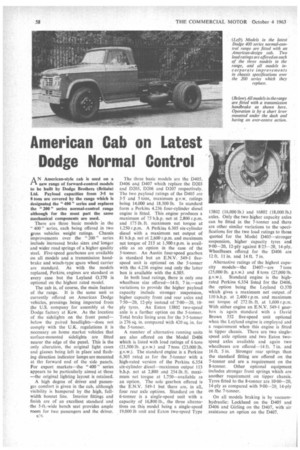American Cab on Latest Dodge Normal Control
Page 60

If you've noticed an error in this article please click here to report it so we can fix it.
AN American-style cab is used on a new range of forward-control models to be built by Dodge Brothers (Britain) Ltd. Payload capacities from 3-5 to 8 tons are covered by the range which is designated the " 400 " series and replaces the " 200 " series normal-control range although for the most part the same mechanical components are used.
There are three basic models in the "400" series, each being offered in two gross vehicles weight ratings. Chassis improvements over the "200" series include increased brake sizes and and wider road springs of a higher quality steel. Five-speed gearboxes are available on all models and a transmission handbrake and winch-type spare wheel carrier are standard. As with the models replaced, Perkins engines are standard in every case but the Leyland 0.370 is optional on the highest rated model.
The cab is, of course, the main feature of the range. It is the same unit as currently offered on American Dodge vehicles, pressings being imported from the U.S. company for assembly at the Dodge factory at Kew. As the location of the sidelights on the front panel— below the paired headlights—does not comply with the U.K. regulations it is necessary on home market vehicles that surface-mounted sidelights are fitted nearer the edge of the panel. This is the only alteration, the original light cases and glasses being left in place and flashing direction indicator lamps are mounted at the forward end of the side panels. For export markets—the "400" series appears to be particularly aimed at these —the original lighting layout is retained.
A high degree of driver and passenger comfort is given in the cab, although visibility is hampered by the high, fullwidth bonnet line. Interior fittings and finish are of an excellent standard and -the 5-ft-wide bench seat provides ample room for two passengers and the driver. The three basic models are the D405, 0406 and D407 which replace the D203 and D205, D206 and D207 respectively. The two payload ratings of the D405 are 3-5 and 5 tons, maximum g.v.w. ratings being 14,000 and 18,500 lb. In standard form a Perkins 4.236 four-cylinder diesel engine is fitted. This engine produces a maximum of 75 b.h.p. net at 2,800 r.p.m. and 175 lb. ft. maximum net torque at 1,250 r.p.m. A Perkins 6.305 six-cylinder diesel with a maximum net output of 81 b.h.p. net at 2,600 r.p.m. and maximum net torque of 215 at 1,500 r.p.m. is available as an option in the case of the 5-tormer. An Austin four-speed gearbox is standard but an E.N.V. 549-1 fivespeed unit is optional on the 5-tonner with the 4.236 engine and only the latter box is available with the 6.305.
In both load ratings, there is only one wheelbase size offered-14 ft. 7 in.—and variations to provide the higher payload capacity include stronger suspension, higher capacity front and rear axles and 7-50-20, 12-ply instead of -7-130-20, 10ply tyres. An Eaton 13802 two-speed axle is a further option on the 5-tonner. Total brake lining area for the 3-5-tonner is 276 sq. in. compared with 420 sq. in. for the 5-tormer.
A number of alternative running units are also offered on the Model D406 which is listed with load ratings of 6 tons (21,500 lb. g.v.w.) and 7 tons (23,00011,. g.v.w.). The standard engine is a Perkins 6.305 rated as for the 5-tonner with a high-rated version of the Perkins 6.354 six-cylinder diesel—maximum output 113 b.h.p. net at 2,800 and 254 lb. ft. maximum net torque at 1,750—available as an option. The sole gearbox offered is the E.N.V. 549-1 but there are, in all, four rear axle options. Standard on the 6-tonner is a single-speed unit with a capacity of 16,800 lb., the three alternatives on this model being a single-speed 19,000 lb unit and Eaton two-speed Type 13802 (16,000 lb.) and 16802 (18,000 lb.) axles. Only the two higher capacity axles can be fitted in the 7-tonner and there are other similar variations to the -specifications for the two load ratings to those quoted for the Model D405—stronger suspension, higher capacity tyres and 9-00--20, 12-ply against 8-25-20, 14-ply. Wheelbases offered for the D406 are 121t. 11 in. and 14 ft. 7 in.
Alternative ratings of the highest capacity models—the D407—are 7 tons (25,000 lb. g.v.w.) and 8 tons (27,000 lb. g.v.w.). Standard engine is the highrated Perkins 6.354 listed for the D406, the option being the Leyland 0.370 which gives a maximum net output of 110 b.h.p. at 2,400 r.p.m. and maximum net torque of 272 lb. ft. at 1,600 r.p.m. With either engine an E.N.V. 549-1 gearbox is again standard with a David Brown 552 five-speed unit optional when the Leyland engine is employed and a requirement when this engine is fitted in tipper chassis. There are two singlespeed axle options and two Eaton twospeed axles available and again two wheelbases are offered-14 ft. 7 in. and 16 ft. 5 in. Stronger rear springs than the standard fitting are offered on the 7-tonner and are a requirement on the 8-tonner. Other optional equipment includes stronger front springs which are another requirement on tipper chassis. Tyres fitted to the 8-tonner are 10-00-20, 14-ply as compared with 9-00-20, 14-ply on the 7-tonner.
On all models braking is by vacuumhydraulic: Lockheed on the D405 and D406 and Girling on the D407, with air assistance an option on the D407.








































































































































































